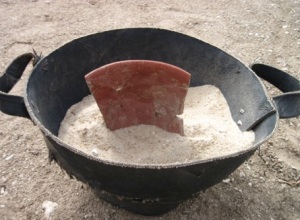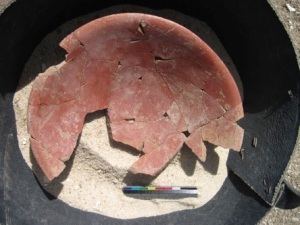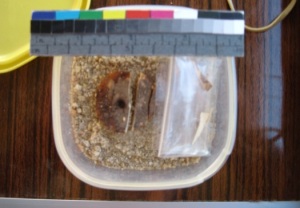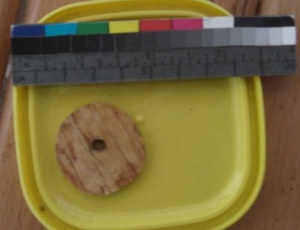Saturday, February 16, 2013
Although assessing the condition of the wall paintings in the Palace – especially in the King’s bedroom, was my primary role this season, the excavation in the south village provided opportunities to treat objects as well. There are very few objects discovered on-site – the village was abandoned once the festival was completed; however, a bowl and a bone disc were found among the ruins of the temporary homes of the palace workers.
The bowl was associated with a section of collapsed ceiling. It was a large, shallow red-ware bowl. The surface was burnished and is in good condition. There are some losses in the surface of the ceramic; these losses may be due to wear or could be due to salt crystallization.
Salts, in solution, can travel through the pores in a pot. Once the water evaporates however, the salts begin to crystalize. These crystals are much larger than the pores that the salts entered while in solution and these newly formed crystals will create damage and loss as they form. There were square salt crystals on the surface of some of the sherds. As such salts donot appear to exist on all pottery at the site, it is likely that these salts are from whatever the bowl held originally!Pottery is fragile and will break into pieces (sherds) under the weight of a collapsed roof or even under the soil that has covered the site over time. About two-thirds of our bowl is preserved, so reassembling it was like putting together a puzzle without the benefit of a photograph.
To reassemble a pot, a conservator always uses an adhesive that is no stronger than the pot itself. A strong adhesive can cause undue stress to the ceramic and if the it breaks again, the goal is for the bowl to re-break along the original lines and not create a new ‘sherd’ that is a thin section of ceramic on either side of adhesive. It is also important that the adhesive be reversible; if more sherds are found, joins can be taken apart so the newly discovered sherds can be added.Once the positions of the sherds were found, reattaching them could begin. The sherds were slowly reassembled – starting from the base – allowing the adhesive to set before adding new pieces. If too many sherds are added at one time, the bowl may collapse from the weight. However, with patience, the shape of the bowl reemerges. This makes photography and sketching of the true shape of the bowl much easier than when it is numerous pieces.
A bone disc was also found in the North Village. This disc is small and round with a hole pierced in the center. The disc had broken into four pieces, one of which was delaminating. (Think of the fragment as two pieces of paper stuck together. If the two sheets of paper come apart, they delaminated.)
However, like the bowl mentioned above, the disc could be repaired. The adhesive in this case, however, had to be weaker than the adhesive used for the bowl as the bone of the disc is weaker than the ceramic of the bowl. Once clean and reassembled, the disc begins to appear closer to what was when in use some 3300 years ago.
Katie Etre





Leave a comment